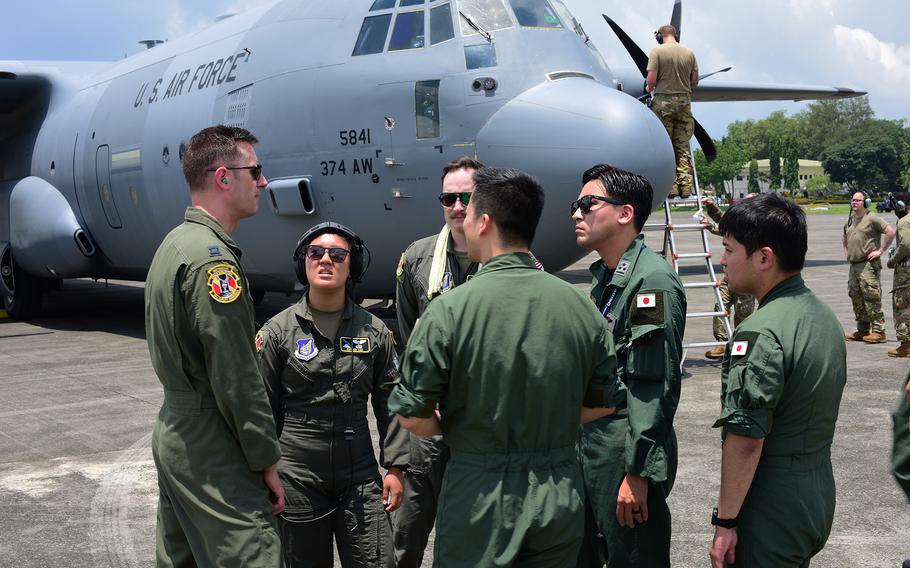
Airmen from the U.S Air Force’s Yokota Air Base, Japan, and the Japan Air Self-Defense Force discuss upcoming operations for Pacific Airlift Rally 2023 at Clark Air Base, Philippines, Aug. 14, 2023. (Robert Webb/U.S. Air Force)
YOKOTA AIR BASE, Japan — The Philippines, long accustomed to typhoons, last week welcomed contingents from about a dozen other countries to practice the skills they need to bring relief in the event of a disaster.
The Pacific Airlift Rally is a five-day, multinational humanitarian aid and disaster relief exercise in which participants rehearse food drops, evacuations and medical care in austere conditions, among other skills. The Philippines hosted the biennial exercise for the first time.
Nearly 800 participants from U.S. Pacific Air Forces, the Philippine army and their counterparts from Malaysia, Indonesia, Japan, Bangladesh, Brunei and other nations joined in the exercise at Clark Air Base that concluded Friday, according to a Wednesday news release from the Philippine Information Agency.
Yokota Air Base, a U.S. airlift hub in western Tokyo, sent two C-130J Super Hercules to the rally, according to an Aug. 8 news release from Pacific Air Forces.
Between 18 and 20 typhoons strike the Philippines every year, the most recent, Super Typhoon Doksuri, or Super Typhoon Egay in the Philippines, in July. Disaster relief is an urgent need in areas devastated and inaccessible after these powerful storms.
“The Philippines is an area where a lot of humanitarian aid, disaster relief action happens,” said Capt. Tim Kim, a C-130J pilot with the 36th Airlift Squadron at Yokota.
“So, it is a very relevant place to be doing and practicing this kind of activity,” Kim told Stars and Stripes during a Signal call Thursday.
Doksuri made landfall July 28 in the northern Philippines, bringing winds of 137 mph and heavy flooding that caused rivers to overflow and left thousands without power. At least 26 people died and 40 were rescued after a ferry capsized July 27 in Laguna de Bay in Rizal province, east of Manila.
In the typhoon’s wake, 35 U.S. Marines and sailors, four MV-22B Ospreys and four CH-53E Super Stallions, preparing to return home from the Philippines, transitioned instead to relief and lifesaving assistance, according to a news release by U.S. Indo Pacific Command.
“It’s beautiful,” said Kim, of Seattle. “It makes you kind of realize that, you know, all the training we put in can actually makes a difference.”
Pacific Airlift Rally, begun in 1997, was held in Indonesia last year. The Philippines is the 10th nation to host the exercise, according to the Philippine Information Agency.
“It is a cool opportunity for us to integrate,” Kim said. “This year for the flying training portion we had the U.S, Philippines, Indonesia, Japan and Malaysia all fly together.”
The aircrews practiced air drop delivery of small bundles, Kim said. In real life, they would drop supplies such as water or food. During the exercise they dropped 300-pound water jugs attached to parachutes to simulate the bundles.
The 36th also took part in a mass casualty scenario Thursday. Kim and his crew flew the squadron aero medical team with a Filipino team from Clark Air Base to Mactan-Benito Ebuen Air Base, a 75-minute flight.
“The Philippines is an important partner for the United States in this area of the world, especially with its proximity to other countries in the area of responsibility,” Kim said.